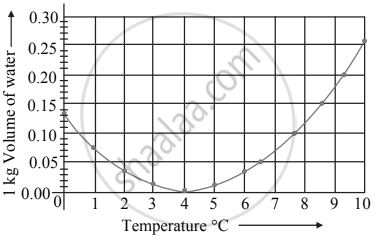Advertisements
Advertisements
प्रश्न
उत्तर
Temperature in °C = 1°C
C/100 = (F-32)/180
F = 1 x 18/10 + 32
= 33.8°F
APPEARS IN
संबंधित प्रश्न
Fill in the blank and rewrite the sentence.
The amount of water vapour in air is determined in terms of its ........... .
A 50 kg man is running at a speed of 18 km h−1. If all the kinetic energy of the man can be used to increase the temperature of water from 20°C to 30°C, how much water can be heated with this energy?
Consider the situation of the previous problem. Assume that the temperature of the water at the bottom of the lake remains constant at 4°C as the ice forms on the surface (the heat required to maintain the temperature of the bottom layer may come from the bed of the lake). The depth of the lake is 1.0 m. Show that the thickness of the ice formed attains a steady state maximum value. Find this value. The thermal conductivity of water = 0.50 W m−1°C−1. Take other relevant data from the previous problem.
Draw a graph between volume and temperature, when 5 cm3 of ice at -10°C is heated to form water at +10°C.
Explain, why are the exposed water pipes lagged with straw during severe winter?
The following diagrams illustrate three situations involving thermometers which are labeled A, Band C. In each situation the thermometers indicate different readings.
(i) What do you expect the approximate reading of the thermometer B and C would be? Give a reason for your answer.
(ii) How would the readings of A and B help you in calibrating a thermometer?

Observe the given graph and answer the following questions:

- Name the process represented in the figure.
- At what temperature does this process take place?
In cold regions, in winter the pipes for water supply break.
